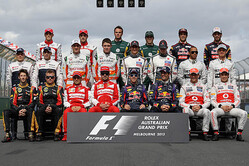


17/02/2014
FEATURE BY GUEST AUTHORS
 The odometer on my Grandmother's 1991 Toyota Corolla reads just over 30,000 kilometres. Since Grandma purchased the silver-trimmed-with-rust coloured chariot 23 years ago, she has averaged roughly 1,300 km per year tooting back and forth to Tuesday Night Bingo. Yet, even with this next-to-never driving schedule, our family matriarch would need just three months to qualify for her FIA super licence.
The odometer on my Grandmother's 1991 Toyota Corolla reads just over 30,000 kilometres. Since Grandma purchased the silver-trimmed-with-rust coloured chariot 23 years ago, she has averaged roughly 1,300 km per year tooting back and forth to Tuesday Night Bingo. Yet, even with this next-to-never driving schedule, our family matriarch would need just three months to qualify for her FIA super licence.
Much has been made of the growing pay-driver pandemic in the world's premier racing series. But South American oil money is not alone to blame. The FIA has made a mockery of its licensing system by granting their stamp of approval to just about any cash-endowed biped who applies, with all due respect to Mr Yuji Ide, of course.
Current FIA standards require aspiring drivers to complete 300 km in Formula One machinery to qualify for their licence. That's just a few hours in the car. This mileage can be conducted during private testing when cars are not compliant with all F1 regulations. Turn on the traction control and even Billy Joel could make it around Jerez enough times to satisfy the governing body.
It's time the FIA restricts the amount of super licences available by installing a competitive application process for hopeful F1 pilots. Consider the following:
All licences expire after the season's final Grand Prix. F1 drivers who finish in the top 12 receive automatic licence renewal for the following year. Assuming a final grid of 22 cars, that leaves ten positions available for new applicants. Stars from the world's top racing series - including GP2, DTM, Formula Renault, IndyCar, WRC and, yes, even NASCAR - are invited to apply, as well as the remaining F1 tail-enders.
Enter the FIA comité de selection du pilote.
Comprised of a select group of former drivers, the committee assesses applications, debates merits and votes for the best candidates. Factors like mechanical failures, strength of competition, hindering injuries and propensity for being run off the road by Romain Grosjean are all taken into account.
Once a 22-driver field is set, all licensed drivers are free to negotiate contracts with F1's constructors. Naturally, the teams offering the most money score the biggest names. The more frugal outfits are left to choose from whoever remains, with a minimum salary imposed.
So, how different would the 2014 grid look?
Finishing 12th would allow Paul di Resta one more kick at the carbon fibre, while Davide Valsecchi, Bruno Spengler and Andre Lotterer could finally see their big-league ambitions come to fruition. Heikki Kovalainen would be welcomed back with open arms. Heck, even Jimmie Johnson might become a "lucky dog" after the application process concluded.
On the other hand, say "adios, auf wiedersehen and cheerio" to the likes of Esteban Gutierrez, Adrian Sutil and Max Chilton. Also falling victim to relegation would be, with great satisfaction, one Pastor Maldonado.
Under this system, Mr Maldonado must use whatever cash he has left to buy the best IndyCar drive David Letterman can offer, win the series outright and reapply to F1 for 2015. Even so, if Grandma finally gets serious and submits her super licence application, poor Pastor may still find himself on the side-lines - where he and all the other pay drivers belong. Formula One is only for the best.